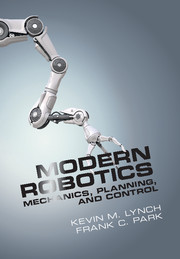Book contents
- Frontmatter
- Contents
- Foreword by Roger Brockett
- Foreword by Matthew Mason
- Preface
- 1 Preview
- 2 Configuration Space
- 3 Rigid-Body Motions
- 4 Forward Kinematics
- 5 Velocity Kinematics and Statics
- 6 Inverse Kinematics
- 7 Kinematics of Closed Chains
- 8 Dynamics of Open Chains
- 9 Trajectory Generation
- 10 Motion Planning
- 11 Robot Control
- 12 Grasping and Manipulation
- 13 Wheeled Mobile Robots
- A Summary of Useful Formulas
- B Other Representations of Rotations
- C Denavit–Hartenberg Parameters
- D Optimization and Lagrange Multipliers
- Bibliography
- Index
5 - Velocity Kinematics and Statics
Published online by Cambridge University Press: 04 June 2024
- Frontmatter
- Contents
- Foreword by Roger Brockett
- Foreword by Matthew Mason
- Preface
- 1 Preview
- 2 Configuration Space
- 3 Rigid-Body Motions
- 4 Forward Kinematics
- 5 Velocity Kinematics and Statics
- 6 Inverse Kinematics
- 7 Kinematics of Closed Chains
- 8 Dynamics of Open Chains
- 9 Trajectory Generation
- 10 Motion Planning
- 11 Robot Control
- 12 Grasping and Manipulation
- 13 Wheeled Mobile Robots
- A Summary of Useful Formulas
- B Other Representations of Rotations
- C Denavit–Hartenberg Parameters
- D Optimization and Lagrange Multipliers
- Bibliography
- Index
Summary
In the previous chapter we saw how to calculate the robot end-effector frame's position and orientation for a given set of joint positions. In this chapter we examine the related problem of calculating the twist of the end-effector of an open chain from a given set of joint positions and velocities.
Before we reach the representation of the end-effector twist as V ϵ R6, starting in Section 5.1, let us consider the case where the end-effector configuration is represented by a minimal set of coordinates x ϵ Rm and the velocity is given by x˙ = dx/dt ϵ Rm. In this case, the forward kinematics can be written as
where θ ϵ Rn is a set of joint variables. By the chain rule, the time derivative at time t is
where J(θ) ϵ Rm×n is called the Jacobian. The Jacobian matrix represents the linear sensitivity of the end-effector velocity x˙ to the joint velocity θ˙, and it is a function of the joint variables θ.
To provide a concrete example, consider a 2R planar open chain (left-hand side of Figure 5.1) with forward kinematics given by
Differentiating both sides with respect to time yields
which can be rearranged into an equation of the form x˙ = J(θ)θ˙:
Writing the two columns of J(θ) as J1(θ) and J2(θ), and the tip velocity x as
vtip, Equation (5.1) becomes
As long as J1(θ) and J2(θ) are not collinear, it is possible to generate a tip velocity vtip in any arbitrary direction in the x1–x2-plane by choosing appropriate joint velocities θ˙1 and θ˙2. Since J1(θ) and J2(θ) depend on the joint values θ1 and θ2, one may ask whether there are any configurations at which J1(θ) and J2(θ) become collinear. For our example the answer is yes: if θ2 is 0◦ or 180◦ then, regardless of the value of θ1, J1(θ) and J2(θ) will be collinear and the Jacobian J(θ) becomes a singular matrix. Such configurations are therefore called singularities; they are characterized by a situation where the robot tip is unable to generate velocities in certain directions.
- Type
- Chapter
- Information
- Modern RoboticsMechanics, Planning, and Control, pp. 146 - 186Publisher: Cambridge University PressPrint publication year: 2017



